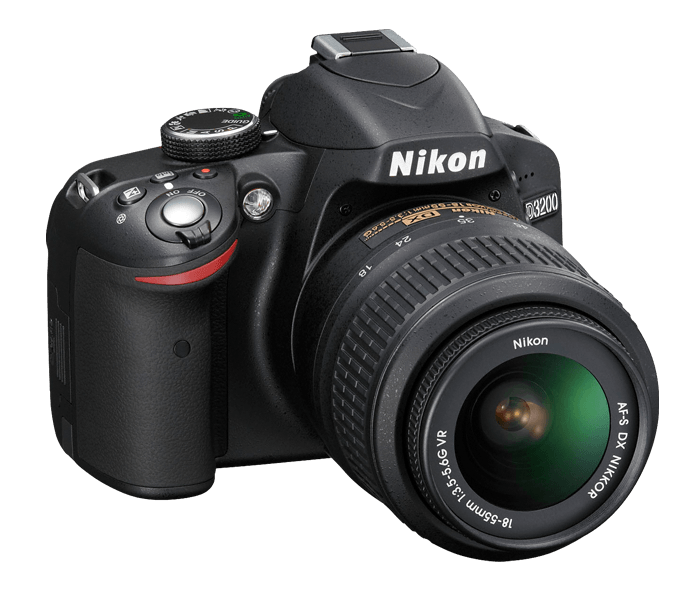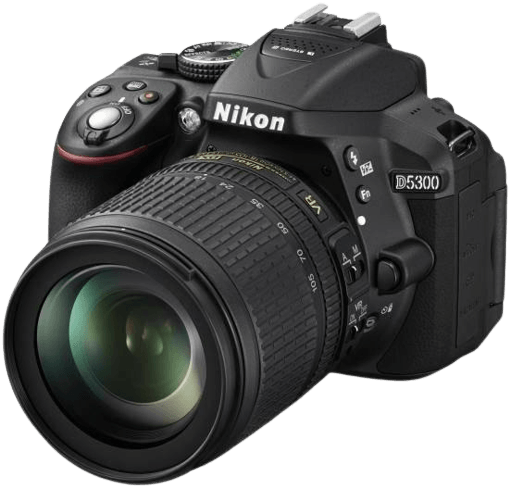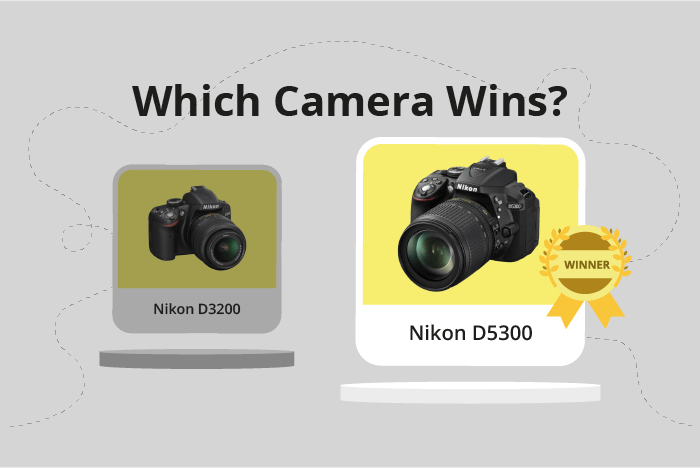Nikon D3200 vs D5300 Comparison
Nikon D3200

Nikon D5300

The Nikon D5300 emerges as the winner with a score of 57/100, while the Nikon D3200 trails closely behind at 54/100. Both cameras share similarities as DSLRs with their announcement dates in 2012 and 2013. They also have almost identical camera sizes, with the D3200 measuring 125 x 96 x 77mm and the D5300 at 125 x 98 x 76mm.
The Nikon D5300 has advantages over the D3200, including a slightly higher score and a lighter weight of 480g (1.06lbs) compared to the D3200’s 505g (1.11lbs). However, the D3200 has its own merits, such as a lower launch price of $699, compared to the D5300’s $800.
Taking all factors into account, the Nikon D5300 proves to be a better camera with its higher score and lighter weight. However, the Nikon D3200 is still a viable option for those seeking a more affordable DSLR.
Nikon D3200 vs D5300 Overview and Optics
The Nikon D5300 outperforms the Nikon D3200 in optics, scoring 65/100 compared to the D3200’s 63/100. Both cameras share similar specifications, such as 24.2 megapixels, CMOS sensor type, APS-C sensor size, Nikon F DX lens mount, and lack of image stabilization.
The Nikon D5300 has a slight edge over the D3200 due to its faster shooting speed of 5 frames per second (fps) compared to the D3200’s 4 fps. This allows for better capturing of fast-moving subjects or action scenes. Additionally, the D5300 features an Expeed 4 processor, an improvement from the D3200’s Expeed 3 processor. This results in better image processing, noise reduction, and overall image quality. The D5300 also has a higher DXOMARK score for its sensor (83) compared to the D3200 (81), indicating a slightly better performance in color depth, dynamic range, and low-light capabilities.
On the other hand, the Nikon D3200 still performs well in optics, despite its lower score. It shares the same megapixels, sensor type, sensor size, and lens mount as the D5300. While it may have a slower shooting speed and older processor, the D3200 still produces high-quality images and is a reliable option for photographers.
Considering these points, the Nikon D5300 is the better choice for those who prioritize faster shooting speed and improved image processing. However, the Nikon D3200 remains a solid option for photographers who value similar specifications and performance at a potentially lower price point.
Nikon D3200 vs D5300 Video Performance
The Nikon D5300 outperforms the Nikon D3200 in video capabilities, scoring 70 out of 100, compared to the D3200’s score of 43. Both cameras share some common specifications, such as Full HD maximum video resolution and 1920 x 1080 maximum video dimensions. However, there are noticeable differences that make the D5300 a superior choice for video recording.
The D5300 has a higher maximum video frame rate of 60fps, while the D3200 only offers 30fps. This means that the D5300 can capture smoother and more detailed video, especially in fast-paced situations or when recording sports and action scenes. Additionally, the D5300 has built-in time-lapse functionality, allowing users to create stunning time-lapse videos without the need for additional software or equipment. This feature is not available in the D3200.
On the other hand, the D3200’s lower video score does not necessarily mean it is utterly inferior. For casual users who do not require advanced video features or high frame rates, the D3200’s 30fps and Full HD resolution may be sufficient for their needs. Moreover, the D3200 is typically more affordable than the D5300, making it a suitable option for budget-conscious consumers.
Taking these factors into account, the Nikon D5300 is the clear winner for video capabilities, offering a higher frame rate and built-in time-lapse functionality. The Nikon D3200, while not as advanced, remains a viable option for those seeking basic video features at a more affordable price point.
Nikon D3200 vs D5300 Features and Benefits
The Nikon D5300 emerges as the winner in the features comparison with a score of 46/100, while the Nikon D3200 lags behind with a score of 41/100. Both cameras share some specifications, including a 3-inch screen size and the absence of a touchscreen. Neither camera offers Bluetooth connectivity.
The D5300 outperforms the D3200 in several aspects. It boasts a larger screen size of 3.2 inches and a higher screen resolution of 1,037,000 dots, providing a sharper and more detailed display. The D5300 also features a flip screen, allowing for more versatile shooting angles and better framing of subjects. Additionally, the D5300 comes with GPS and WIFI capabilities, enabling geotagging of images and seamless sharing of photos with other devices.
The D3200, on the other hand, has a smaller screen size of 3 inches and a lower screen resolution of 921,000 dots. It lacks a flip screen, GPS, and WIFI capabilities. However, the D3200 still delivers high-quality images and performance, making it a reliable option for photographers on a budget or those who do not require advanced features.
Based on these comparisons, the Nikon D5300 offers more advanced features, making it the better choice for photographers seeking versatility and additional functionalities. The Nikon D3200 remains a solid option for those who prioritize image quality and performance over advanced features.
Nikon D3200 vs D5300 Storage and Battery
The Nikon D5300 outperforms the Nikon D3200 in storage and battery, scoring 29/100 compared to the D3200’s 27/100. Both cameras share some common specifications, including one memory card slot and compatibility with SD, SDHC, and SDXC memory cards. Neither camera offers USB charging.
The D5300 surpasses the D3200 in battery life, providing 600 shots per charge, while the D3200 offers 540 shots. The D5300 uses the EN-EL14a battery type, which might contribute to its longer battery life. However, the D3200 does have an advantage in memory card compatibility, supporting UHS-I compatible cards, which can provide faster transfer speeds.
Considering the storage and battery aspects, the Nikon D5300 offers better battery life, making it a more suitable option for extended photography sessions. On the other hand, the Nikon D3200’s UHS-I compatibility is a notable advantage for users prioritizing faster transfer speeds.
Nikon D3200 vs D5300 – Our Verdict
Are you still undecided about which camera is right for you? Have a look at these popular comparisons that feature the Nikon D3200 or the Nikon D5300:

